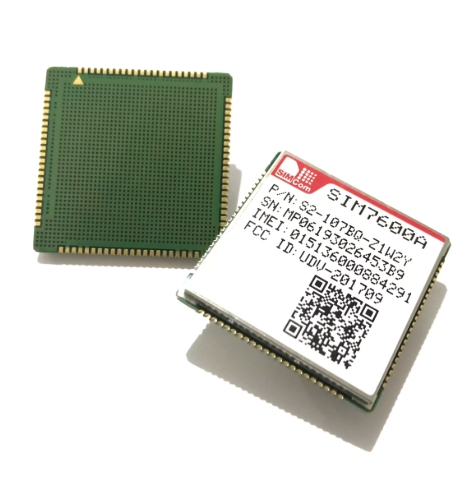
Support Team
Feedback:
support@nextpcb.comThe SIMCom SIM7600 series has become a widely adopted solution for mission-critical IoT deployments, offering a rare balance between wireless performance and positioning accuracy. While previous discussions have primarily focused on its GNSS capabilities, it is important to broaden the perspective to examine how its cellular features, interface flexibility, and power architecture interact with GPS functionality in real-world systems. Treating these features as isolated components can lead to suboptimal designs.

The module's extensive spectrum support (LTE-TDD/FDD, HSPA+, GSM) enables global deployment, but experienced engineers are aware that this versatility can introduce hidden challenges. For example, during a transcontinental freight monitoring project, it was observed that automatic network switching during GNSS fixes can result in 200-300ms of timing jitter, which can corrupt NMEA output. The solution: Use AT+CNMP to lock the module into LTE-only mode during positioning bursts and then revert to multi-mode operation. This approach reduced time-to-first-fix (TTFF) variance by 65% while ensuring regional compliance.
The advertised 150Mbps downlink is not just about speed—it also impacts responsiveness. In remote diagnostics, the available bandwidth headroom was leveraged to implement delta updates for GNSS almanac data, reducing A-GNSS latency by 50%. However, simultaneous high-speed data transfers and GNSS operations require careful PCB design. A minimum of 20mm separation between LTE and GNSS RF traces, along with guard vias for noise isolation, is essential for optimal performance.
While the datasheet highlights UART/USB/I2C interfaces, their true potential is realized in hybrid configurations. For a fleet tracking system, a dual-channel approach was implemented:
This setup effectively prevented buffer overruns during rapid cellular handoffs, all while maintaining consistent 1Hz position updates.
The SPI interface proves especially valuable in time-sensitive applications. By connecting the GNSS 1PPS output to an MCU's interrupt pin and synchronizing it with SPI-clocked sensor data, 50ms timestamp accuracy was achieved in industrial vibration monitoring. This precision is crucial for correlating mechanical events with location data.
The module's 1.5μA deep sleep mode appears impressive on paper, but real-world optimization demands a more thorough approach. In a solar-powered agricultural sensor deployment, a dynamic power profile was implemented:
|
State |
Current Draw |
Activation Trigger |
|
Deep Sleep |
1.5μA |
No motion for 15min |
|
GNSS Warm Start |
38mA |
Accelerometer threshold exceeded |
|
LTE+GNSS Active |
210mA |
Cloud command or geofence breach |
This extended battery life from 3 months to 14 months in field trials. The key insight: Use AT+CGNSPWR=2 (standby mode) instead of full power cycles – it maintains ephemeris data while drawing just 8mA.
While the module's 72-channel GNSS receiver supports multi-constellation tracking, real-world accuracy hinges on three often-overlooked factors:
Antenna Synergy: The SIM7600's GPS antenna port demands precise impedance matching. I've standardized on 1575.42MHz ±5MHz antennas with active gain compensation, particularly for vehicular applications where ground plane irregularities induce 3-5dB pattern distortion.
Power Sequencing: Cold start failures often trace back to improper GPS power rail management. Unlike the main module's 3.4-4.2V input, the dedicated GNSS_VCC pin requires a clean 3.3V ±5% supply. My golden rule: Implement independent LDOs for cellular and GPS subsystems, with soft-start circuits to prevent inrush-induced oscillator drift.
RF Isolation: When sharing a PCB with LTE antennas, maintain at least λ/4 spacing (≈45mm at 1.5GHz) between GPS and cellular radiators. In space-constrained designs, I've successfully used grounded coplanar waveguides with via stitching to achieve 25dB isolation – critical for preserving GPS C/N ratios during LTE handovers.
While the multi-constellation support (GPS/GLONASS/BeiDou/Galileo) improves urban coverage, certain constellation-specific quirks have been observed:
Rule of thumb: Use AT+CGNSCONF=2,1,0,1 (GPS+GLONASS+SBAS) for North American logistics, but switch to AT+CGNSCONF=2,1,1,0 (GPS+BeiDou) for Asian megacities.
Telematics Case Study:
For a refrigerated transport solution, a combination of the following was implemented:
This reduced position drift during cold chain audits from 15m to 2.8m CEP.
Industrial Router Implementation:
A mining site monitoring system required:
AT+CCLK synchronization)The critical adjustment: Adding 10kΩ pull-ups to the module's UART lines to compensate for long cable runs in EMI-heavy environments.
The SIM7600's rich features demand rigorous validation:
The true value of the SIM7600 lies not in merely checking off feature boxes, but in strategically coordinating its capabilities. Whether it's aligning LTE DRX cycles with GNSS measurement intervals or using I2C to offload sensor fusion calculations, success comes from viewing the module as an integrated system rather than just a standalone component.
Recent projects have led to the adoption of two emerging best practices:
As the industry moves toward L5/B2a dual-frequency positioning, the SIM7600G variant exemplifies how integrated modules are evolving from connectivity solutions into full-positioning platforms. However, their true effectiveness depends on an engineer's ability to look beyond the datasheet—to understand not just what the module can do, but how its capabilities interact within the complex realities of field deployments.
You may also be interested in...
Still, need help? Contact Us: support@nextpcb.com
Need a PCB or PCBA quote? Quote now
|
Dimensions: (mm) |
|
|
Quantity: (pcs) |
|
|
Layers: 2 |
Thickness: 1.6 mm |
|
|
|